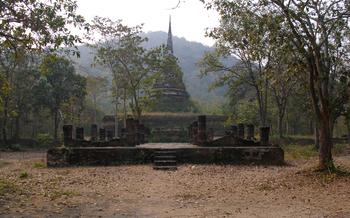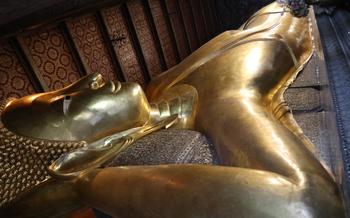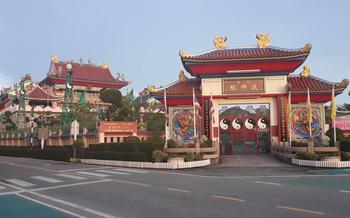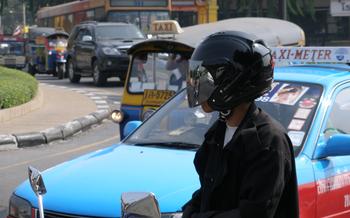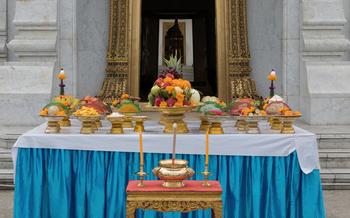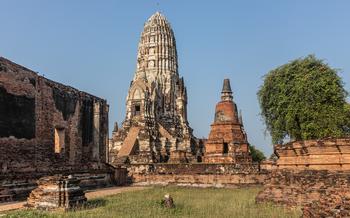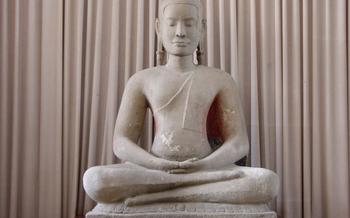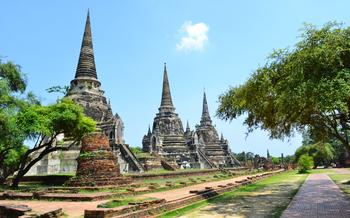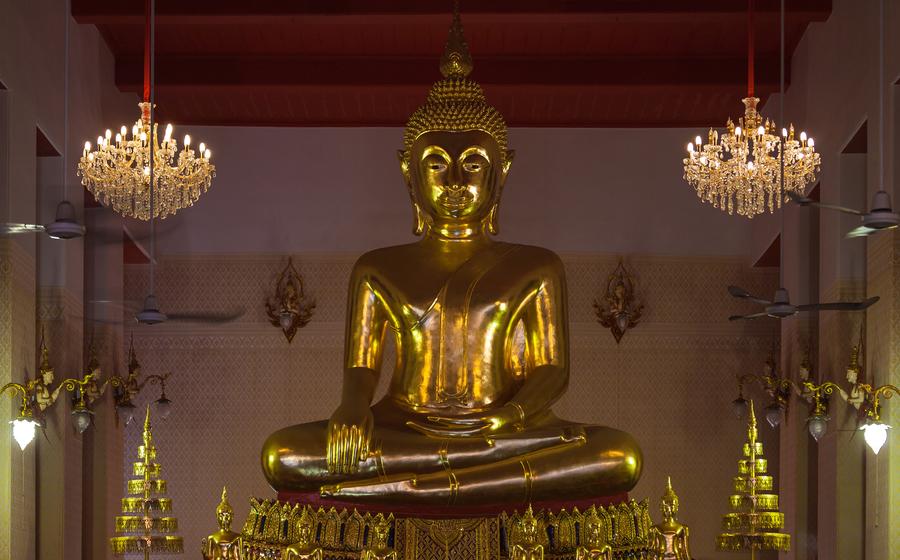
Wat Mahathat
- Location and Accessibility
- Opening Hours and Admission Fees
- Dress Code and Etiquette
- Exploring the Temple Grounds
- The Majestic Prang
- The Ordination Hall: A Sacred Space for Buddhist Rituals
- The Wihan
- The Bell Tower: A Symbol of Time and Tradition
- The Surrounding Area
- Local Festivals and Events
- Insider Tip
Location and Accessibility
Wat Mahathat is conveniently located in the heart of Bangkok, making it easily accessible by various transportation options. The temple's address is 288 Maha Rat Road, Phra Nakhon, Bangkok 10200, Thailand. To reach Wat Mahathat, visitors can take the MRT (subway) and alight at Sam Yot Station. From there, it's a short walk of approximately 5 minutes to the temple. Alternatively, visitors can opt for a taxi or tuk-tuk ride, which is a great way to experience the city's vibrant atmosphere.
In the vicinity of Wat Mahathat, visitors can find several other notable landmarks and attractions worth exploring. The Grand Palace and Wat Pho, two of Bangkok's most iconic temples, are just a short walk away. Visitors can also explore the bustling Khao San Road, a backpacker's paradise known for its lively nightlife, shopping, and dining options.
Opening Hours and Admission Fees
Wat Mahathat is open to visitors daily, allowing travelers to immerse themselves in its spiritual and historical significance at their convenience. The temple welcomes guests from 8:30 AM to 6:30 PM, providing ample time to explore its sacred grounds and admire its architectural wonders. During peak tourist season, the temple may extend its hours to accommodate the influx of visitors.
Admission to Wat Mahathat is subject to a modest entrance fee, which contributes to the maintenance and preservation of this sacred site. The standard admission fee for foreign visitors is 50 Thai Baht (approximately 50 USD). However, Thai nationals and residents of Thailand are granted free admission, allowing them to connect with their cultural heritage without financial barriers.
On special occasions such as Buddhist holidays or national celebrations, Wat Mahathat may offer free admission to all visitors as a gesture of goodwill and to encourage cultural exchange. These free admission days provide an excellent opportunity for travelers to experience the temple's spiritual essence without any financial constraints.
Dress Code and Etiquette
Respecting the sacredness of Wat Mahathat requires visitors to adhere to appropriate attire and conduct. Dress modestly by covering your shoulders and knees. Avoid revealing or transparent clothing. When entering the temple grounds, remove your shoes and place them neatly in the designated racks. Refrain from wearing shorts, tank tops, or beachwear, as these are considered disrespectful in a religious setting.
While exploring the temple, maintain a respectful demeanor and avoid loud or disruptive behavior. Keep your voice low and refrain from engaging in conversations that may disturb the tranquility of the temple. Remember that Wat Mahathat is an active religious site, and silence is often observed during meditation or prayer. Be mindful of the monks and other visitors who may be seeking a peaceful and spiritual experience.
Photography is permitted within the temple grounds, but it is important to be mindful of your surroundings and avoid taking photos of monks or other visitors without their consent. Flash photography is generally discouraged as it can be disruptive and disrespectful. Always ask for permission before taking photos of people or sacred objects, and be prepared to respect their wishes if they decline.
Exploring the Temple Grounds
Wat Mahathat's sprawling complex is a testament to its rich history and religious significance. As you step through the temple gates, you'll be greeted by a serene and spiritual atmosphere that invites contemplation and exploration. The layout of the temple grounds is designed to guide visitors on a journey of discovery, showcasing its architectural wonders and sacred spaces.
At the heart of the complex lies the majestic prang, a towering spire that dominates the skyline. Surrounding the prang are several smaller prangs, each representing a different era in the temple's history. These prangs are adorned with intricate carvings and sculptures, depicting scenes from Buddhist mythology and the life of Buddha.
As you continue your exploration, you'll encounter the reclining Buddha, a colossal statue that exudes an aura of peace and tranquility. The statue's serene expression and intricate details are a testament to the skill and devotion of the ancient artisans who created it.
Another highlight of Wat Mahathat is the ordination hall, a sacred space where young men are ordained as Buddhist monks. The hall's elegant architecture and beautiful murals depict scenes from the Buddha's life and teachings.
Don't miss the opportunity to visit the chedi, a towering stupa that enshrines sacred relics of the Buddha. The chedi's design symbolizes the Buddha's path to enlightenment, with its ascending tiers representing the different stages of his spiritual journey.
Finally, take some time to explore the wihan, or assembly hall, where monks gather for prayers and meditation. The wihan's interior is adorned with stunning murals and Buddha images, creating a serene and contemplative space.
Whether you choose to explore Wat Mahathat independently or with a knowledgeable guide, the temple's rich history, stunning architecture, and sacred spaces will leave a lasting impression and provide a deeper understanding of Thai culture and Buddhism.
The Majestic Prang
At the heart of Wat Mahathat stands the majestic prang, a towering structure that dominates the temple's skyline and serves as its most iconic landmark. This grand spire, constructed in the Ayutthaya architectural style, rises high above the surrounding buildings, symbolizing the temple's spiritual significance and connection to the heavens.
The prang's design is a testament to the architectural prowess of the ancient Thai artisans. Its graceful curves and intricate details showcase their mastery of form and proportion. The spire is adorned with delicate stucco decorations, depicting mythical creatures and scenes from Buddhist mythology, which add to its visual appeal and religious symbolism.
Beyond its architectural beauty, the prang holds deep religious significance in Thai culture. It represents Mount Meru, the mythical mountain that is considered the center of the universe in Buddhist cosmology. As such, the prang serves as a sacred symbol of the temple's connection to the divine realm and the Buddha's teachings.
In recent years, the prang underwent a meticulous restoration process aimed at preserving its grandeur and historical significance. This extensive project involved careful cleaning, repair, and restoration of the spire's intricate details, ensuring that this architectural masterpiece continues to stand as a symbol of Wat Mahathat's enduring legacy.
The Ordination Hall: A Sacred Space for Buddhist Rituals
Within the hallowed grounds of Wat Mahathat, the ordination hall stands as a testament to the temple's profound spiritual significance. Its architecture exudes a serene elegance, characterized by intricate carvings, sweeping eaves, and a multi-tiered roof that reaches towards the heavens.
The ordination hall serves as the sacred venue for a pivotal Buddhist ritual—the ordination ceremony. Here, young men and women embark on a transformative journey, renouncing their worldly attachments to embrace the path of monasticism. In this sacred space, they receive the precepts of the Buddhist faith, marking the beginning of their spiritual transformation.
Beyond its ceremonial function, the ordination hall also houses a treasure trove of artistic wonders. The walls are adorned with exquisite murals that depict scenes from the life of Buddha, narrating his teachings and exemplifying the virtues of compassion, wisdom, and enlightenment. These vibrant and intricate artworks not only enhance the beauty of the hall but also serve as a source of inspiration and contemplation for visitors.
As you step into the ordination hall, a palpable sense of reverence and tranquility envelops you. The air is heavy with the scent of incense and the gentle chanting of monks, creating an atmosphere conducive to reflection and introspection. Let the serene beauty of this sacred space wash over you, allowing your mind to be still and your spirit to soar.
The Wihan
The wihan, or assembly hall, is a prominent structure within the Wat Mahathat complex. It serves as a gathering place for monks and laypeople to participate in religious ceremonies, meditation, and teachings. The wihan at Wat Mahathat is renowned for its beautiful architecture and intricate decorations.
The wihan features a spacious interior with high ceilings supported by massive pillars. The walls are adorned with vibrant murals depicting scenes from the life of Buddha and significant events in Buddhist history. These murals are not mere embellishments but serve as didactic tools, narrating stories and teachings to the faithful.
The wihan houses several notable Buddha images, each with its unique significance. The most revered image is the Phra Buddha Sihing, a highly revered Buddha statue cast in gold and adorned with precious gems. This statue is believed to have been created in the 13th century and is considered one of the most sacred Buddha images in Thailand.
The wihan's interior is a testament to the artistry and devotion of the ancient craftsmen who created it. The intricate carvings, delicate stucco work, and colorful murals combine to create a truly awe-inspiring space. Visitors can spend hours exploring the wihan, admiring its beauty, and contemplating its spiritual significance.
The Bell Tower: A Symbol of Time and Tradition
Amidst the serene temple grounds, the bell tower stands tall, its elegant structure reaching towards the heavens. Constructed in the traditional Thai architectural style, the bell tower features intricate carvings and decorative elements that showcase the artistry and craftsmanship of its creators.
The purpose of the bell tower extends beyond its aesthetic appeal. Historically, the bell played a crucial role in the daily lives of the local community. Its resonant sound marked the passage of time, signaling the hours of the day and summoning the monks for their religious observances. The bell's melodic chimes also served as a reminder of the temple's presence, connecting the community to their spiritual center.
Beyond its practical function, the bell tower holds significant religious symbolism. In Buddhism, the sound of the bell is believed to have the power to dispel evil spirits and purify the mind. It is also associated with the concept of mindfulness, as its gentle ringing encourages practitioners to be present and aware.
To this day, the bell tower remains an integral part of Wat Mahathat's spiritual and cultural heritage. Its melodious chimes continue to echo through the temple grounds, reminding visitors of the passage of time and the enduring traditions of Thai Buddhism.
The Surrounding Area
Beyond the temple grounds, visitors can immerse themselves in the vibrant local culture and explore the surrounding area. Just a short walk away, the bustling markets and shopping streets offer a delightful experience for those seeking authentic Thai souvenirs and handicrafts. From colorful textiles and intricate carvings to aromatic spices and delicious street food, the markets are a feast for the senses.
For those wishing to savor the local cuisine, a plethora of restaurants and eateries line the streets surrounding Wat Mahathat. From humble food stalls offering mouthwatering curries and noodle dishes to upscale establishments serving elegant Thai fusion cuisine, there's something to cater to every taste and budget.
For those seeking a longer stay, the area surrounding Wat Mahathat offers a range of accommodation options. From budget-friendly guesthouses and hostels to luxurious hotels with stunning views of the temple, visitors can choose the perfect place to rest and recharge after a day of exploration.
Local Festivals and Events
Wat Mahathat plays a central role in several important festivals and events throughout the year. One of the most significant is the Phra Buddha Sihing Procession, held annually in April. During this festival, the sacred Phra Buddha Sihing image is carried in a grand procession through the streets of Bangkok, passing by Wat Mahathat. Devotees line the streets, paying homage to the revered Buddha image and seeking blessings.
Another notable event is the Songkran Festival, also known as the Thai New Year, which takes place in April. During Songkran, Wat Mahathat becomes a hub for water-splashing festivities, with locals and visitors alike engaging in playful water fights to symbolize cleansing and renewal.
If you're fortunate enough to visit Wat Mahathat during one of these festivals, you'll have the opportunity to immerse yourself in the vibrant Thai culture and witness the deep devotion of the local people. These events offer a unique glimpse into the spiritual heart of Thailand and create lasting memories for visitors.
Insider Tip
-
Photography Spots: Venture beyond the main tourist areas to discover hidden gems within the temple grounds. Explore the serene gardens, secluded corners, and lesser-known shrines to capture unique and Instagram-worthy shots. The intricate details of the temple's architecture, the lush greenery, and the serene atmosphere provide endless opportunities for stunning photographs.
-
Crowds: To fully appreciate the tranquility and sacredness of Wat Mahathat, plan your visit wisely. Avoid weekends and public holidays, which tend to attract large crowds. Instead, opt for a weekday morning or late afternoon visit. This will allow you to explore the temple at your own pace, soak in the spiritual ambiance, and capture the beauty of the site without the hustle and bustle of the crowds.
